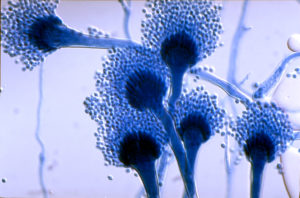MOLD CENTRAL: General
What are molds?
http://www.doh.wa.gov/YouandYourFamily/HealthyHome/Contaminants/Mold.aspx
Molds are fungi that can be found both indoors and outdoors. No one knows how many species of fungi exist but estimates range from tens of thousands to perhaps three hundred thousand or more. Molds grow best in warm, damp, and humid conditions, and spread and reproduce by making spores. Mold spores can survive harsh environmental conditions, such as dry conditions, that do not support normal mold growth.
What are some of the common indoor molds?
•Cladosporium
•Alternaria
•Aspergillus
How do molds affect people?
Some people are sensitive to molds. For these people, exposure to molds can cause symptoms such as nasal stuffiness, eye irritation, wheezing, or skin irritation. Some people, such as those with serious allergies to molds, may have more severe reactions. Severe reactions may occur among workers exposed to large amounts of molds in occupational settings, such as farmers working around moldy hay. Severe reactions may include fever and shortness of breath. Some people with chronic lung illnesses, such as obstructive lung disease, may develop mold infections in their lungs.
In 2004 the Institute of Medicine (IOM) found there was sufficient evidence to link indoor exposure to mold with upper respiratory tract symptoms, cough, and wheeze in otherwise healthy people; with asthma symptoms in people with asthma; and with hypersensitivity pneumonitis in individuals susceptible to that immune-mediated condition. The IOM also found limited or suggestive evidence linking indoor mold exposure and respiratory illness in otherwise healthy children. In 2009, the World Health Organization issued additional guidance, the WHO Guidelines for Indoor Air Quality: Dampness and Mold
Where are molds found?
Molds are found in virtually every environment and can be detected, both indoors and outdoors, year round. Mold growth is encouraged by warm and humid conditions. Outdoors they can be found in shady, damp areas or places where leaves or other vegetation is decomposing. Indoors they can be found where humidity levels are high, such as basements or showers.
How can people decrease mold exposure?
Sensitive individuals should avoid areas that are likely to have mold, such as compost piles, cut grass, and wooded areas. Inside homes, mold growth can be slowed by keeping humidity levels between 40% and 60%, and ventilating showers and cooking areas. If there is mold growth in your home, you should clean up the mold and fix the water problem.
Specific Recommendations:
– Keep the humidity level in the house between 40% and 60%.
– Use an air conditioner or a dehumidifier during humid months.
– Be sure the home has adequate ventilation, including exhaust fans.
– Add mold inhibitors to paints before application.
– Clean bathrooms with mold killing products.
– Do not carpet bathrooms and basements.
– Remove or replace previously soaked carpets and upholstery.
Contact AuntieGen Today!

